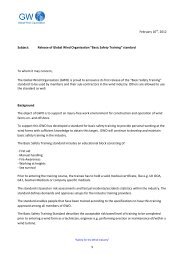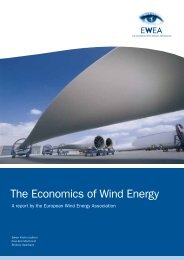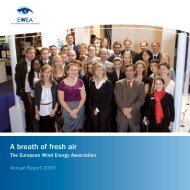Offshore Electricity Infrastructure in Europe - European Wind Energy ...
Offshore Electricity Infrastructure in Europe - European Wind Energy ...
Offshore Electricity Infrastructure in Europe - European Wind Energy ...
You also want an ePaper? Increase the reach of your titles
YUMPU automatically turns print PDFs into web optimized ePapers that Google loves.
table 13.7: cORRelatiOn cOeFFicients<br />
Base case direct design Split design<br />
Base case F<strong>in</strong>al design Δ Base case F<strong>in</strong>al design Δ Base case<br />
All w<strong>in</strong>d / all hydro -0.29 -0.32 -0.03 -0.32 -0.03<br />
All w<strong>in</strong>d / all gas -0.05 -0.04 0.01 -0.05 0.01<br />
All w<strong>in</strong>d / all lignite coal -0.36 -0.30 0.06 -0.31 0.05<br />
All w<strong>in</strong>d / all hard coal -0.41 -0.39 0.02 -0.40 0.01<br />
All w<strong>in</strong>d / all “other<br />
renewable”<br />
-0.65 -0.64 0.01 -0.63 0.02<br />
All w<strong>in</strong>d / all nuclear 0.40 0.40 0.00 0.40 0.01<br />
All w<strong>in</strong>d / demand 0.29 0.28 -0.01 0.28 -0.01<br />
Due to the price level changes and the immediate impact<br />
on the benefits of already exist<strong>in</strong>g <strong>in</strong>frastructure<br />
a large number of iterations had to be carried out <strong>in</strong><br />
order to <strong>in</strong>dentify the most beneficial <strong>in</strong>terconnectors.<br />
Please note that the absolute price levels <strong>in</strong> the countries<br />
might <strong>in</strong>crease with further connections. Norway<br />
e.g. exhibits very low price levels <strong>in</strong> the Hub Base<br />
Case scenario 2030. If thus this low price electricity is<br />
sold to other countries the <strong>in</strong>ternal price level rises as<br />
higher priced generation capacity will have to be used.<br />
Please note that Table 13.5 and Table 13.6 only show<br />
price level differences and not absolute price levels.<br />
These price levels decrease <strong>in</strong> general, but also here<br />
<strong>in</strong>creas<strong>in</strong>g price level differences are possible.<br />
D.III.V Power system impact<br />
Balanc<strong>in</strong>g of w<strong>in</strong>d power variability<br />
The offshore grid leads to the spatial smooth<strong>in</strong>g of<br />
short term renewable energy variations and as such<br />
reduces the needs for balanc<strong>in</strong>g power <strong>in</strong> the system<br />
to a certa<strong>in</strong> extent. This paragraph illustrates how the<br />
balanc<strong>in</strong>g of variable w<strong>in</strong>d power is affected by the offshore<br />
grid, with a special focus on the hydro power <strong>in</strong><br />
Scand<strong>in</strong>avia.<br />
A priori, there are two compet<strong>in</strong>g hypotheses:<br />
• the offshore grid enables cheaper generation units<br />
farther away from demand centres to momentarily<br />
replace more expensive generation units <strong>in</strong>dependently<br />
of Scand<strong>in</strong>avian hydro capability,<br />
<strong>Offshore</strong>Grid – F<strong>in</strong>al Report<br />
• the offshore grid improves the utilisation of<br />
Scand<strong>in</strong>avian hydro capability. At low price periods,<br />
Scand<strong>in</strong>avia will import cheaper power from the<br />
surround<strong>in</strong>g areas, and at high price periods, will<br />
export power. This makes more expensive generation<br />
units <strong>in</strong> the surround<strong>in</strong>g areas unnecessary.<br />
Although it was shown <strong>in</strong> section 4.5.6 that there is<br />
an overall shift from hard coal and gas towards the<br />
cheaper category “other renewables” it is not immediately<br />
clear when <strong>in</strong> time this shift occurs. For example,<br />
it could be a shift that is evident hour by hour (first<br />
hypothesis), or a shift that occurs <strong>in</strong>directly via hydro<br />
balanc<strong>in</strong>g (second hypothesis).<br />
Measur<strong>in</strong>g the balanc<strong>in</strong>g of w<strong>in</strong>d power can be done by<br />
evaluat<strong>in</strong>g the correlation coefficients between w<strong>in</strong>d<br />
power production and other power production. A generation<br />
type that balances w<strong>in</strong>d power has a negative<br />
correlation with w<strong>in</strong>d power. This means that it produces<br />
when there is low w<strong>in</strong>d generation and it stops<br />
production when w<strong>in</strong>d power is generated. Table 13.7<br />
shows correlation coefficients between total w<strong>in</strong>d production<br />
and total production of other generation types.<br />
For the assessment of grid <strong>in</strong>fluence on w<strong>in</strong>d power<br />
balanc<strong>in</strong>g, the <strong>in</strong>terest<strong>in</strong>g <strong>in</strong>formation <strong>in</strong> Table 13.7 is<br />
the change <strong>in</strong> correlation coefficients relative to the<br />
base case.<br />
Both the direct and split grid designs have an <strong>in</strong>creased<br />
anti-correlation between w<strong>in</strong>d and hydro<br />
compared to the base case. This is <strong>in</strong>terpreted as an<br />
<strong>in</strong>creased balanc<strong>in</strong>g of w<strong>in</strong>d by the hydro systems. For<br />
141









